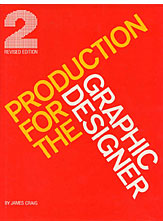|
Production for the Graphic Designer was
first published in 1974 followed by a second edition in 1990.
For the first time, a book that fully and clearly explains the production
of printed matter – written expressly for the graphic designer.
Most graphic designers learn about production in a haphazard manner:
on the job, or struggling through books written for production people.
Production for the Graphic Designer distills the enormous amount of production
detail available into a single volume that not only explains but graphically
illustrates everything the designers needs to know without confusing
them with technical matter they will never use.
Typesetting. The designer is taken through the history of typesetting,
from handsetting to digital composition. Explains the terminology and
type measurements and lists a number of considerations that should be
of concern to anyone working with type.
A selection of typefaces set by various systems helps the designer compare
the “look” of one typeface to another.
Computer Typesetting. A detailed overview of computer typestting describes
the components of a basic system and explains the many terms used by
this new technology.
Printing. How a design becomes a printed piece, from mechanical through
screening, page makeup, platemaking, and printing. The major printing
processes, including printing terms, techniques, and problems.
Paper. The designer is often called upon to select paper, and this section
will help. Lists the basic categories of paper by their generic names rather
than brand names, describing their characteristics, their uses, and the ways
in which the designer can use them to their best advantage.
Inks. What inks are made of; the inks recommended for the different printing
processes; specialty inks and their uses.
Color Printing. The two basic color reproduction methods – flat
(or match color) and four-color printing – are described in
detail, illustrated with multicolor and full-color plates. Discusses
laser separations and electronic color imaging.
Imposition, Folding, and Binding. How the printed sheet becomes a folder,
brochure, or book. The various binding methods--wire stitching, perfect,
mechanical, and edition – and book-covering materials.
Mechanicals. A refresher course on how to handle and scale original art; use
photostats and veloxes; and how to prepare black and white and color mechanicals.
“Excellent, well-conceived, well designed, extremely useful.”
Milton Glaser
“A great great book! What has to be one of the best books that
could possibly have been written for todays practicing graphic designer.”
Aaron Burns
“I wish your new book Production for the Graphic Designer was
around when I was a student. It’s a very clear and sensible book.”
George Lois
“Nothing I have seen approaches it.”
Ben Rosen
“An excellent and, at last, up-to-date book on problems and possibilities
of production.”
Ivan Chermayeff
“An exceptional book.”
Gene Federico
208 pages. 8 1/2 X 11. Over 400 black and white and multi-color illustrations.
16 pages of color. Extensive glossary. Bibliography. Index.
ISBN 0-8230-4416-5
Watson-Guptill Publications
Return to top
|

